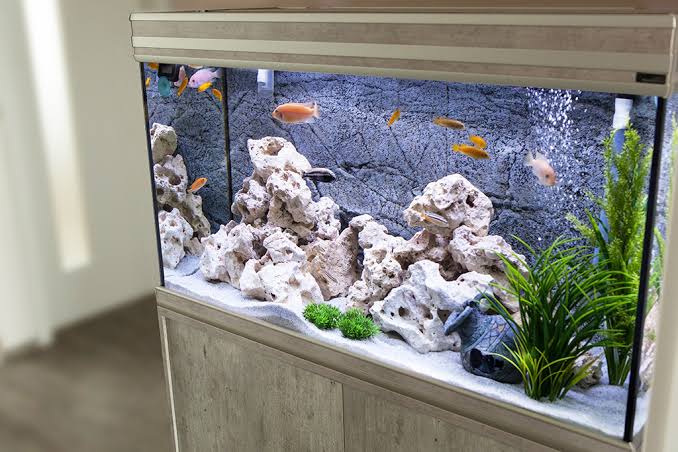
How to Choose the Right Aquarium for Pet Fish: Aquariums are more than just decorative glass boxes they’re ecosystems that house living, breathing creatures. Choosing the right aquarium is the most crucial first step to ensuring your pet fish live long, healthy, and stress-free lives.

Whether you’re eyeing colorful guppies, peaceful tetras, majestic bettas, or exotic cichlids, each fish has specific needs that dictate the size, shape, filtration, and environment of their future home. Selecting the wrong tank can lead to disease, aggression, poor water quality, and premature death.
How to Choose the Right Aquarium for Pet Fish
Step 1: Know Your Fish First
Before choosing an aquarium, decide which type(s) of fish you want to keep. Fish can be broadly grouped into:
1. Freshwater Fish
- Easier to care for, best for beginners
- Examples: Guppies, tetras, mollies, platies, bettas, goldfish
2. Saltwater Fish
- Require more advanced setups, higher costs
- Examples: Clownfish, tangs, wrasses, angelfish
3. Coldwater vs Tropical
- Coldwater: Don’t need a heater (e.g., goldfish)
- Tropical: Need water between 74–80°F (e.g., neon tetras)
Fish vary widely in temperament, space needs, water preferences, and compatibility. Research before you buy.
Step 2: Choose the Right Aquarium Size
Bigger is better—both for fish health and easier maintenance. Small tanks are often unstable and get polluted faster.
Example:
- 5 neon tetras (1.5” each) = 7.5 inches total → Needs a 10-gallon tank minimum
Step 3: Pick the Right Shape and Material
Best overall choice: Rectangular tank (longer = better oxygen exchange)
⚙️ Step 4: Essential Equipment Checklist
Buying an aquarium is only the beginning. Here’s what you’ll need to support your aquatic pets:
Filtration System
Crucial for water quality.
Removes waste, toxins, and excess food. Types include:
- Hang-on-back (HOB): Easy to use, affordable
- Canister filters: Best for large tanks
- Sponge filters: Ideal for betta and shrimp tanks
Choose a filter rated for 1.5x your tank size.
Heater (for tropical fish)
Maintains stable temperature. Look for:
- Adjustable thermostat
- Auto shut-off
- Submersible type
Wattage Rule: 5 watts per gallon
Lighting
Needed for fish health and plant growth.
- LED lights are energy-efficient and customizable Avoid direct sunlight to prevent algae blooms
- Saltwater tanks need special reef lighting
Substrate
The material covering the tank bottom.
- Gravel: Best for freshwater community tanks
- Sand: Preferred for bottom dwellers (e.g., cory catfish)
- Soil: For planted tanks
Decorations and Hiding Places
Fish need enrichment and shelter to reduce stress.
- Use natural-looking rocks, driftwood, caves
- Avoid sharp edges
- Choose aquarium-safe materials only
Water Conditioner
Tap water contains chlorine and metals. Always treat water before adding to the tank.
Thermometer, Test Kits, and Nets
- Thermometer: Stick-on or digital
- Water test kit: Measures pH, ammonia, nitrites, nitrates
- Net: Soft mesh to avoid fin damage
Step 5: Location and Placement
Where you place your aquarium can make or break your setup.
Avoid:
- Direct sunlight → causes algae
- Near heating or cooling vents
- High-traffic, noisy areas
- Unstable or wobbly surfaces
Place on a sturdy stand rated for aquarium weight.
Water weighs ~8.34 lbs per gallon → 20-gallon tank = 166.8 lbs + equipment!
Step 6: Setup and Cycling
Before adding any fish, you must cycle the tank to establish beneficial bacteria that convert toxic ammonia → nitrite → nitrate.
This process takes 3–6 weeks.
Basic Steps:
- Set up tank, substrate, decor, filter, and heater
- Fill with dechlorinated water
- Add ammonia source (fishless preferred) or hardy fish
- Test water weekly until ammonia/nitrite = 0 and nitrate < 40 ppm
- Only then add fish gradually
Skipping the cycle leads to “new tank syndrome” = fish deaths
Ongoing Maintenance
- Daily: Observe fish behavior, feed sparingly
- Weekly: Test water, clean algae, partial water change (20–30%)
- Monthly: Rinse filter media in tank water (never tap!), deep clean decor
READ ALSO: Is Cheese Safe for Cats? The Surprising Truth
Common Mistakes to Avoid
Starting with too small a tank
Overcrowding
Adding incompatible fish
Skipping the nitrogen cycle
Cleaning filter media with tap water
Using non-aquarium-safe decor (e.g., painted rocks, shells)
FAQs
What size tank should a beginner start with?
20 gallons is ideal—big enough to maintain stable water and give fish room, but small enough for easy handling.
Can I keep goldfish in a bowl?
No! Goldfish need 20–30 gallons per fish due to waste production and size. Bowls cause poor health and short lifespans.
Do all fish need filters?
Yes. Even bettas need a gentle filter. Filters help keep toxins down and oxygen up.
What’s the easiest fish for a first tank?
Hardy species like:
- Guppies
- Mollies
- Zebra danios
- Cory catfish
- Cherry barbs
Avoid aggressive or sensitive species initially.
Is it cheaper to buy a tank kit or separate items?
Starter kits are cost-effective but often come with low-quality equipment. Buying separately allows better customization.
Do I need a bubbler or air pump?
Not always. If your filter agitates the surface, that’s enough for oxygenation. Bubblers are more aesthetic or for extra aeration.
Can I mix different types of fish?
Only if they share compatible water parameters, temperament, and tank size needs. Always research each species.
How long do I wait before adding fish after setting up the tank?
At least 3–6 weeks to complete the nitrogen cycle. Use test kits to confirm safety.
What’s the best tank for kids or classrooms?
10–20 gallon freshwater tank with hardy fish like guppies or danios. Teach kids about feeding, cleaning, and biology!
How much does it cost to set up a tank?
- 10-gallon setup: $100–$200
- 20-gallon: $150–$300
- Saltwater: $300+ due to special gear
Leave a Reply
You must be logged in to post a comment.